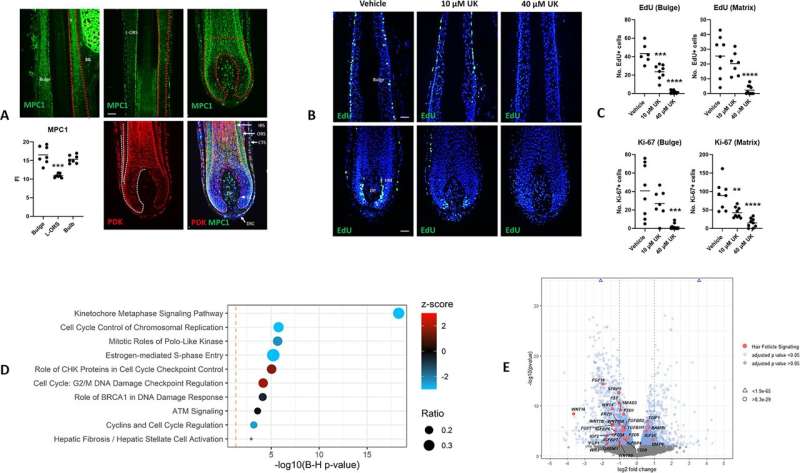
MPC1 is expressed in the human hair follicle, and inhibition of MPC inhibits cell cycle progression and disrupts gene expression of the hair follicle signaling pathway. A) MPC1 and PDK immunoreactivity in human hair follicle. CTS-connective tissue sheath. DP–dermal papilla; DSC–skin wrap cup; GL–germinating layer; HS–hair shaft; IRS-internal root sheath; L-ORS – lower outer root sheath; SG – sebaceous gland. Regional analysis (areas of analysis indicated by dashed red lines) performed on 7 anagen hair follicles from 3 donors. Mann Whitney test, p value *** 0.0006. Scale bar 50 μm. B) Fluorescent EdU labeling in human hair follicle tissue sections shows how UK-5099 treatment blocks DNA replication in the hair follicle both within the swollen epithelium and the hair matrix (HM). DP-dermal papilla. Scale bar 50 μm. C) Quantitative analysis of EdU and Ki-67 in the hair follicle and matrix after UK-5099 treatment. Ordinary one-way anova with multiple comparisons. EdU analyses: Adjusted P-values *** 0.0002, **** <0.0001. Ki-67 analyses: Adjusted P-values ** 0.0018; *** 0.0006; **** <0.0001. N = 2–3 donors (6–10 independent anagen hair follicles per condition). The dashed line is the mean. D) Dot plot of the 10 most enriched IPA pathways after 40 μM UK-5099 treatment. Analysis performed on 1206 genes with 2-fold change and p < 0.05. See also S3 Fig in S1 File. E) Annotated volcano plot of differentially expressed genes involved with FGF, IGF, TGFβ and Wnt signaling with an adjusted p-value < 0.05 after treatment of human hair follicles with 40 μM UK-5099. Credit: PLOS ONE (2024). DOI: 10.1371/ditar.pone.0303742
Scientists at the University of Manchester have linked one of the ways cells respond to stressful conditions with limited growth of healthy hair.
The team at the Manchester Hair Research Group unexpectedly discovered the link in a laboratory experiment where they were testing a drug to see if it would grow human scalp hair follicles in a dish. The study inadvertently led to a link to the cellular stress response—an ancient biological mechanism that occurs throughout life from yeast and roundworms to humans.
The study was published in PLOS ONE.
The team hopes their work targeting the pathway could one day lead to treatments for hair loss.
Fully known as the Integrated Stress Response (ISR), it is triggered under cellular stressful conditions such as poor nutrient availability, viral infection, or when there is an accumulation of unformed proteins in cells. The ISR allows cells to inhibit regular activities by making fewer new proteins, entering a partial stasis to adapt and cope with stress. However, if it doesn’t work, it can cause the cells to die.
ISR is already of great interest to scientists studying cancer, neurodegenerative disorders and aging.
Dr. Talveen Purba, researcher at the University of Manchester and senior author of the study, said: “We were testing a drug that targets metabolism in human hair follicles to affect how cells generate energy, which – based on the work of others – we expected to stimulate stem cells, however, we found that the opposite was true: hair growth was blocked, as cells, including stem cells, quickly stopped dividing.
They also found signs that mitochondria were dysfunctional and there were disruptions in the way cells communicate with each other. Using a combination of experimental approaches to take a closer look, the team found signs that ISR activation was to blame.
Derek Pye, chief technical officer of the research group and co-author of the study, said: “When we look at hair follicles under the microscope, it’s surprising how consistent the response is between hair follicles from different people.”
Following on from this early stage research, the team is now seeking to better understand the wider implications of ISR in hair follicles and examine its activity in people with hair loss conditions.
Dr. Purba added, “We are extremely hopeful as we believe that activating this pathway may play an important biological role in limiting hair growth in people with hair loss conditions, meaning that targeting it could lead to new treatments.”
More information:
Derek Pye et al, Activation of the integrated stress response in human hair follicles, PLOS ONE (2024). DOI: 10.1371/ditar.pone.0303742
Provided by the University of Manchester
citation: Scientists discover surprising link between ancient biology and limited human hair growth (2024, June 20) retrieved June 21, 2024 from https://phys.org/news/2024-06-scientists-link-ancient-biology -restricted.html
This document is subject to copyright. Except for any fair agreement for study or private research purposes, no part may be reproduced without written permission. The content is provided for informational purposes only.